Abstract
Tsunami flow across the geomagnetic field induces electric currents in both the ocean and the ionosphere. These currents generate secondary magnetic fields, observable at the seafloor and on land. Magnetic field disturbances during two Chilean tsunamis (2010 and 2015) were recorded at Easter Island Observatory. These tsunamis were produced after the earthquakes in Chile on February 27, 2010, at 06:34 UTC, and September 16, 2015, at 22:55 UTC, respectively. Differences between existing studies regarding the origin of the tsunamigenic disturbances, and the lack of studies using a numerical model for both the water velocity and the induced magnetic field, motivated us to compare magnetic records with computed magnetic fields for the two events. Modeled disturbances were calculated by applying the Biot–Savart law to tsunami simulations. Our model can calculate tsunami-induced perturbations in the vertical component of the geomagnetic field, obtaining a good agreement with the observations. We hypothesize that the magnetic measurements may be produced by a combination of oceanic and ionospheric electric currents. Our analysis further reveals that even a relatively small tsunami, such as the one produced by the 2015 \(M_\text {w}\) 8.2 earthquake, induces an observable magnetic perturbation due to the water movement. Future improvements to our model may allow us to identify situations in which magnetic variations precede the tsunami arrival, thereby allowing early tsunami detection.












Similar content being viewed by others
References
Aránguiz, R., González, G., González, J., Catalán, P. A., Cienfuegos, R., Yagi, Y., et al. (2017). The 16 September 2015 Chile Tsunami from the post-tsunami survey and numerical modeling perspectives, Pageoph Topical Volumes. In C. Braitenberg & A. B. Rabinovich (Eds.), The Chile-2015 (Illapel) earthquake and tsunami (pp. 219–234). Cham: Birkhüuser.
Bellotti, G., Briganti, R., & Beltrami, G. M. (2012). The combined role of bay and shelf modes in tsunami amplification along the coast. Journal of Geophysical Research: Oceans. https://doi.org/10.1029/2012JC008061.
Benavente, R., Cummins, P. R., & Dettmer, J. (2016). Rapid automated W-phase slip inversion for the Illapel great earthquake (2015, Mw = 8.3). Geophysical Research Letters, 43, 1910–1917. https://doi.org/10.1002/2015GL067418.
Calisto, I., Miller, M., & Constanzo, I. (2016). Comparison between tsunami signals generated by different source models and the observed data of the Illapel 2015 Earthquake. Pure Applied Geophysics, 173(4), 1051–1061. https://doi.org/10.1007/s00024-016-1253-8.
Calisto, I., Ortega, M., & Miller, M. (2015). Observed and modeled tsunami signals compared by using different rupture models of the April 1, 2014, Iquique earthquake. National Hazards, 79(1), 397–408. https://doi.org/10.1007/s11069-015-1848-x.
Campbell, W. H. (2003). Introduction to geomagnetic fields. Cambridge: Cambridge University Press.
Chave, A. D. (1983). On the theory of electromagnetic induction in the Earth by ocean currents. Journal of Geophysical Research: Solid Earth, 88(B4), 3531–3542. https://doi.org/10.1029/JB088iB04p03531.
Dostal, J., Martinec, Z., & Thomas, M. (2012). The modelling of the toroidal magnetic field induced by tidal ocean circulation. Geophysical Journal International, 189(2), 782–798. https://doi.org/10.1111/j.1365-246X.2012.05407.x.
Fritz, H. M., Petroff, C. M., Catalán, P. A., Cienfuegos, R., Winckler, P., Kalligeris, N., et al. (2011). Field survey of the 27 February 2010 Chile Tsunami. Pure and Applied Geophysics, 168(11), 1989–2010. https://doi.org/10.1007/s00024-011-0283-5.
Glimsdal, S., Pedersen, G. K., Harbitz, C. B., & Løvholt, F. (2013). Dispersion of tsunamis: Does it really matter? National Hazards Earth System Science, 13(6), 1507–1526. https://doi.org/10.5194/nhess-13-1507-2013.
Grilli, S. T., Ioualalen, M., Asavanant, J., Shi, F., Kirby, J. T., & Watts, P. (2007). Source constraints and model simulation of the December 26, 2004, Indian Ocean Tsunami. Journal of Waterway, Port, Coastal, and Ocean Engineering, 133(6), 414–428. https://doi.org/10.1061/(ASCE)0733-950X(2007)133:6(414).
Grinsted, A., Moore, J. C., & Jevrejeva, S. (2004). Application of the cross wavelet transform and wavelet coherence to geophysical time series. Nonlinear Processes in Geophysics, 11(5/6), 561–566.
Horrillo, J., Kowalik, Z., & Shigihara, Y. (2006). Wave Dispersion Study in the Indian Ocean-Tsunami of December 26, 2004. Marine Geodesy, 29(3), 149–166. https://doi.org/10.1080/01490410600939140.
Irrgang, C., Saynisch-Wagner, J., & Thomas, M. (2018). Depth of origin of ocean-circulation-induced magnetic signals. Annals of Geophysics, 36(1), 167–180. https://doi.org/10.5194/angeo-36-167-2018.
Kherani, E. A., Lognonné, P., Hébert, H., Rolland, L., Astafyeva, E., Occhipinti, G., et al. (2012). Modelling of the total electronic content and magnetic field anomalies generated by the 2011 Tohoku-Oki tsunami and associated acoustic-gravity waves. Geophysics Journal International, 191(3), 1049–1066. https://doi.org/10.1111/j.1365-246X.2012.05617.x.
Kherani, E. A., Rolland, L., Lognonné, P., Sladen, A., Klausner, V., & de Paula, E. R. (2016). Traveling ionospheric disturbances propagating ahead of the Tohoku-Oki tsunami: A case study. Geophysics Journal International, 204(2), 1148–1158. https://doi.org/10.1093/gji/ggv500.
Klausner, V., Almeida, T., de Meneses, F. C., Kherani, E. A., Pillat, V. G., & Muella, M. T. A. H. (2016). Chile 2015: Induced magnetic fields on the Z component by tsunami wave propagation. Pure Applied Geophysics, 173(5), 1463–1478. https://doi.org/10.1007/s00024-016-1279-y.
Klausner, V., Mendes, O., Domingues, M. O., Papa, A. R. R., Tyler, R. H., Frick, P., et al. (2014). Advantage of wavelet technique to highlight the observed geomagnetic perturbations linked to the Chilean tsunami (2010). Journal of Geophysical Research: Space Physics, 119(4), 3077–3093. https://doi.org/10.1002/2013JA019398.
Koper, K. D., Hutko, A. R., Lay, T., & Sufri, O. (2012). Imaging short-period seismic radiation from the 27 February 2010 Chile (Mw 8.8) earthquake by back-projection of P, PP, and PKIKP waves. Journal of Geophysical Research: Solid Earth, 117(B2), 2156–2202. https://doi.org/10.1029/2011JB008576.
Larsen, J. C. (1968). Electric and magnetic fields induced by deep sea tides. Geophysical Journal of the Royal Astronomical Society, 16(1), 47. https://doi.org/10.1111/j.1365-246X.1968.tb07135.x.
Larsen, J. C. (1973). An introduction to electromagnetic induction in the ocean. Physics of the Earth and Planetary Interiors, 7(3), 389–398. https://doi.org/10.1016/0031-9201(73)90063-0.
Levin, B. W., & Nosov, M. A. (2016). Physics of tsunamis. Dordrecht: Springer.
Liu, P. L.-F., Woo, S.-B., & Cho, Y.-S. (1998). Computer programs for tsunami propagation and inundation. Ithaca: Cornell University.
Manoj, C., Kuvshinov, A., Maus, S., & Lühr, H. (2006). Ocean circulation generated magnetic signals. Earth Planets Space, 58(4), 429–437. https://doi.org/10.1186/BF03351939.
Manoj, C., Maus, S., & Chulliat, A. (2011). Observation of magnetic fields generated by tsunamis. Eos, Transactions American Geophysical Union, 92(2), 13–14. https://doi.org/10.1029/2011EO020002.
Masamura, K., Fujima, K., Goto, C., Iida, K., & Shigemura, T. (2000). Theoretical solution of long wave considering the structure of bottom boundary layer and examinations on wave decay due to sea bottom friction. Journal of Hydraulic, Coastal and Environmental Engineering, JSCE, No663/II-53, 69–78.
Minami, T., Toh, H., Ichihara, H., & Kawashima, I. (2017). Three-dimensional time domain simulation of tsunami-generated electromagnetic fields: Application to the 2011 Tohoku earthquake tsunami. Journal of Geophysical Research: Solid Earth, 122(12), 9559–9579. https://doi.org/10.1002/2017JB014839.
Minami, T., Toh, H., & Tyler, R. H. (2015). Properties of electromagnetic fields generated by tsunami first arrivals: Classification based on the ocean depth. Geophysical Research Letters, 42(7), 2171–2178. https://doi.org/10.1002/2015GL063055.
Mori, N., Takahashi, T., Yasuda, T., & Yanagisawa, H. (2011). Survey of 2011 Tohoku earthquake tsunami inundation and run-up. Geophysical Research Letters. https://doi.org/10.1029/2011GL049210.
Okada, Y. (1985). Surface deformation due to shear and tensile faults in a half-space. Bulletin of the Seismological Society of America, 75, 1135–1154.
Okal, E. A., & Synolakis, C. E. (2016). Sequencing of tsunami waves: Why the first wave is not always the largest. Geophysical Journal International, 204(2), 719–735. https://doi.org/10.1093/gji/ggv457.
Pukhtyar, L. D., & Kukushkin, A. S. (1996). Investigation of the electromagnetic fields induced by sea wave motion. Physical Oceanography, 7(1), 33–41. https://doi.org/10.1007/BF02509823.
Sanford, T. (1971). Motionally induced electric and magnetic fields in the sea. Journal of Geophysical Research, 76(15), 3476–3492. https://doi.org/10.1029/JC076i015p03476.
Schnepf, N. R., Manoj, C., An, C., Sugioka, H., & Toh, H. (2016). Time-frequency characteristics of tsunami magnetic signals from four pacific ocean events. Pure Applied Geophysics, 173(12), 3935–3953. https://doi.org/10.1007/s00024-016-1345-5.
Tatehata, H., Ichihara, H., & Hamano, Y. (2015). Tsunami-induced magnetic fields detected at Chichijima Island before the arrival of the 2011 Tohoku earthquake tsunami. Earth Planets Space, 67(1), 185. https://doi.org/10.1186/s40623-015-0347-3.
Torrence, C., & Compo, G. P. (1998). A practical guide to wavelet analysis. Bulletin of the American Meteorological Society, 79(1), 61–78. https://doi.org/10.1175/1520-0477(1998)079<0061:APGTWA>2.0.CO;2.
Tyler, R. H. (2005). A simple formula for estimating the magnetic fields generated by tsunami flow. Geophysical Research Letters. https://doi.org/10.1029/2005GL022429.
Tyler, R. H., Maus, S., & Lühr, H. (2003). Satellite observations of magnetic fields due to ocean tidal flow. Science, 299(5604), 239–241. https://doi.org/10.1126/science.1078074.
Tyler, R. H., & Mysak, L. A. (1995). Motionally-induced electromagnetic fields generated by idealized ocean currents. Geophysical and Astrophysical Fluid Dynamics, 80(3–4), 167–204. https://doi.org/10.1080/03091929508228954.
Utada, H., Shimizu, H., Ogawa, T., Maeda, T., Furumura, T., Yamamoto, T., et al. (2011). Geomagnetic field changes in response to the 2011 off the Pacific Coast of Tohoku Earthquake and Tsunami. Earth and Planetary Science Letters, 311, 11–27. https://doi.org/10.1016/j.epsl.2011.09.036.
Wang, X. (2009). User manual for COMCOT version 1.7 (first draft). Ithaca: Cornell University.
Wang, B., Guo, X., Liu, H., & Gong, C. (2015). On the magnetic anomaly at Easter Island during the 2010 Chile tsunami. Theoretical and Applied Mechanics Letters, 5(5), 187–190. https://doi.org/10.1016/j.taml.2015.08.001.
Wessel, P., Smith, W. H. F., Scharroo, R., Luis, J., & Wobbe, F. (2013). Generic mapping tools: Improved version released. Eos, Transactions American Geophysical Union, 94(45), 239–241. https://doi.org/10.1002/2013EO450001.
Yamazaki, Y., & Cheung, K. F. (2011). Shelf resonance and impact of near-field tsunami generated by the 2010 Chile earthquake. Geophysical Research Letters. https://doi.org/10.1029/2011GL047508.
Zhang, L., Utada, H., Shimizu, H., Baba, K., & Maeda, T. (2014). Three-dimensional simulation of the electromagnetic fields induced by the 2011 Tohoku tsunami. Journal of Geophysical Research: Solid Earth, 119(1), 150–168. https://doi.org/10.1002/2013JB010264.
Acknowledgements
C. Torres would like to thank Programa Formación de Capital Humano Avanzado (PFCHA) of the Comisión Nacional de Investigación Científica y Tecnológica (CONICYT), Chile, for the financial support of his PhD (CONICYT PFCHA/DOCTORADO NACIONAL/2015—21150632). The authors would like to thank the International Real-time Magnetic Observatory Network (INTERMAGNET) for the dataset used in this work, Chambon-La-Forêt Observatory and Institut de Physique du Globe de Paris (IPGP) as creators of the Easter Island Observatory (with funding from National Aeronautics and Space Administration, NASA), the Hydrographic and Oceanographic Service of the Chilean Navy (SHOA) for the bathymetry data, Departamento de Ingeniería Matemática of Universidad de Concepción for computational support regarding data processing, and M. Miller for his assistance with the production of figures and the improvement of the manuscript. The DART records are available from NOAA’s National Data Buoy Center at http://www.ndbc.noaa.gov/dart.shtml. Wavelet software was provided by C. Torrence and G. Compo, and is available at URL: http://atoc.colorado.edu/research/wavelets/. Figures in this study are produced using Matlab R2017b and the Generic Mapping Toolkit of Wessel et al. (2013). Finally, the authors thank the Editor and the two anonymous reviewers for their constructive comments and suggestions.
Author information
Authors and Affiliations
Corresponding author
Rights and permissions
About this article
Cite this article
Torres, C.E., Calisto, I. & Figueroa, D. Magnetic Signals at Easter Island During the 2010 and 2015 Chilean Tsunamis Compared with Numerical Models. Pure Appl. Geophys. 176, 3167–3183 (2019). https://doi.org/10.1007/s00024-018-2047-y
Received:
Revised:
Accepted:
Published:
Issue Date:
DOI: https://doi.org/10.1007/s00024-018-2047-y




